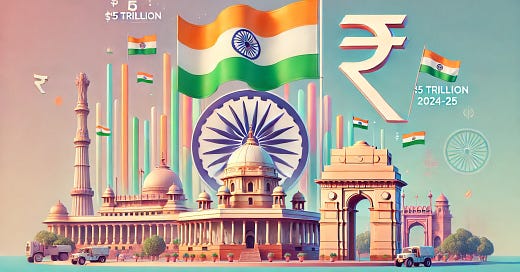FM Nirmala Sitharaman's 2024-25 Budget: What We Need, What We Expect
Indian Government's 2024-25 Budget Coming Up In July: What We Want, What We Expect.
Interim Budget in the Election Year
India's Budget for the financial year 2024-25 was an interim budget, presented by Finance Minister Nirmala Sitharaman on February 1, 2024. This presentation took place ahead of the general elections scheduled for later in the year. An interim budget is a stopgap measure, designed to cover essential government expenditures for a few months— till July 2024— until a new government is formed and can present a full Budget. This ensures the continuity of financial operations during the transition period.
Transition to Full Budget
Following the elections, Prime Minister Narendra Modi's government was re-elected for a third term and sworn in early June 2024. The full-fledged Union Budget for 2024-25 is anticipated to be presented by Finance Minister Sitharaman in the second half of July 2024, likely during the Monsoon Session of Parliament. This budget will undergo discussions in both Houses of Parliament—the Lok Sabha and the Rajya Sabha—before the Finance Bill, which ratifies the taxation proposals, is sent to the President for final approval.
Aspiring for a $5 Trillion Economy
The aspirational target of transforming India into a $5 trillion economy in the next few years underscores the importance of strategic fiscal planning and investments. The upcoming full budget will play a critical role in setting the course for achieving this ambitious goal by focusing on key areas such as infrastructure, human capital development, and governance reforms.
Fiscal Overview of the Interim Budget 2024-25
The Indian Government's interim budget for the fiscal year 2024-25 presents a mixed picture in terms of fiscal management and developmental priorities. Although the authorisation by Parliament for expenditure through the approval of the Appropriation Bill was limited to the first four months, the projections are for the full year 2024-25. In this sense, it goes beyond a typical interim budget. Nevertheless, this allows Finance Minister Nirmala Sitharaman the flexibility to make necessary changes with prospective effect in the “full” Budget to be now presented.
The fiscal deficit is estimated at 5.1% of GDP, while the revenue deficit is pegged at 2% of GDP. Despite these figures being lower than the previous year, they remain significant concerns for the economy.
Obligatory Expenditures
A substantial portion of the budget is committed to obligatory expenditures such as salaries, pensions, debt servicing, and defence. Salaries and pensions alone account for nearly 12% of the total expenditure. Interest payments on debt constitute 25% of the total expenditure and 40% of revenue receipts. Defence expenditure, at ₹6,21,540 crore, forms 13.04% of the total budget.
Subsidies
The allocation for food and fertilizer subsidies, though lower than the previous year, still constitutes a considerable burden on the exchequer. The food subsidy, at ₹3,05,250 crore including PM-GKAY, has increased from last year. Fertilizer subsidy, at ₹1,64,150 crore, has decreased but remains high.
Health and Education
In contrast, the outlays for health and education, critical for human capital development, remain inadequate. The health budget, at ₹98,461 crore, constitutes just 2.5% of the total expenditure and has declined as a percentage of GDP. Similarly, the education budget, though seeing an increase, forms only 2.5% of the total expenditure. Within this, the allocation for school education is ₹73,498 crore and for higher education is ₹47,619 crore.
Capital Expenditure
Consequently, the allocation for capital expenditure, crucial for infrastructure development and long-term growth, remains constrained. Capital expenditure is budgeted at ₹11,11,111 crore, forming 23.3% of the total expenditure. While this is an increase from the previous year, it falls short of the investment needed to propel India into a $5 trillion economy.
Reorienting the Budget
To fully capitalize on the opportunities presented by a $5 trillion economy, India needs to reorient its budget towards productive investments in physical and social infrastructure. This requires a concerted effort to rationalize subsidies, expand the tax base, improve compliance, and explore innovative financing mechanisms.
Proposed Reforms
Some key reforms that could help improve the government's fiscal position include:
Expanding the divisible pool of taxes by including cesses and surcharges
Rationalizing Centrally Sponsored Schemes and giving states more untied funds
Extending GST compensation to states for a few more years
Incentivizing states to devolve more funds and powers to local bodies
Revisiting horizontal devolution criteria to balance equity and efficiency
Allowing states to levy income taxes to reduce vertical imbalance
Institutionalizing the GST Council and Inter-State Council for cooperative federalism
Steps in the Right Direction
The government has taken some steps in the right direction, such as increasing capital expenditure, providing production-linked incentives, and reducing corporate tax rates to boost investments. However, more comprehensive reforms in taxation, expenditure management, and federal fiscal relations are needed.
What We Expect
a.) The Path to a $5 Trillion Economy
Becoming a $5 trillion economy is an ambitious goal that requires not just an increase in GDP but also improvements in human development, infrastructure, and governance. The budget is a key instrument to allocate resources towards these priorities. By focusing on inclusive growth, social sector investments, and fiscal prudence, India can lay the foundation for a prosperous and equitable future. The vision is clear, but the path requires bold reforms and resolute implementation.
b.) Addressing Growth and Inflation Concerns
While the consensus figure for India's current growth rate is 7% to 8%, inflation and surging unemployment, coupled with a significant fiscal deficit, remain pressing concerns. The middle class—especially those with salaried incomes—are looking forward to the Finance Minister to provide relief beyond symbolic cuts, advocating for a tax rate no higher than that applied to corporates. A greater focus on investment in the social sector is required to address these challenges comprehensively.
c.) Leveraging Non-Fiscal Measures
Additionally, the Finance Minister could seize this opportunity to rely on non-fiscal measures, such as massive deregulation, especially in the area of Foreign Direct Investment (FDI) and environmental clearances. This would not only attract external investment but also spur domestic growth.
d.) Expectations from the Modi 3.0 Government
Coming as it does in the first budget session of the Modi 3.0 Government, Ms. Sitharaman's Budget is being anticipated with great hope and expectations. The 1.4 billion citizens of the country look forward to a budget that addresses their needs and propels India towards its ambitious $5 trillion economy target. Let's hope she does not disappoint.
If you believe this article would interest someone you know, please feel free to share it anonymously (for us), using any platform that you prefer.







Need to minimise subsidies and should be given to deserving and needful sections only.
Public sector should be strengthened.
Infrastructure needs to be developed .
To ensure Old age pension for all senior citizens. Salaries and pensions for politicians and top beaurocrates should not be increased at any cost and upper limit should be fixed whereas hike should be given in class iv and three emploees salaries and pensions.
Many more advices can be given but no use of that because govt already know all this.
ਗਰੀਬਾਂ ਅਤੇ ਮੱਧਵਰਗੀ ਲੋਕਾਂ ਨੂੰ ਮੰਗਤਿਆਂ ਦੀ ਤਰਾਂ ਰਿਆਇਤਾਂ ਅਤੇ ਖਿਰਾਇਤਾਂ ਦੇ ਚੱਕਰ ਵਿੱਚ ਫਸਾ ਕੇ ਦੇਸ਼ ਦੇ ਧਨ ਦਾ ਸੱਭ ਤੋਂ ਵੱਡਾ ਹਿੱਸਾ ਉਦਯੋਗਪਤੀਆਂ ਨੂੰ ਸਬਸਿਡੀਆਂ ਦੇ ਰੂਪ ਵਿੱਚ ਲੁਟਾ ਦਿੱਤਾ ਜਾਵੇਗਾ ਫਿਰ ਚੋਣਾਂ ਵਿੱਚ ਇਹ ਲੋਕ ਮੀਂਹ ਵਾਂਗੂੰ ਪੈਸੇ ਖਰਚ ਕੇ ਇਹਨਾਂ ਨੂੰ ਜਿਤਾਉਣਗੇ ਇਹ ਸਿਲਸਿਲਾ ਚੱਲਦਾ ਰਹੇਗਾ ਜੀ ।